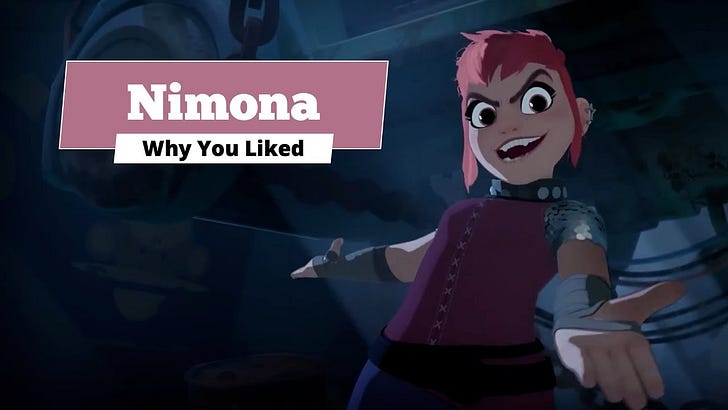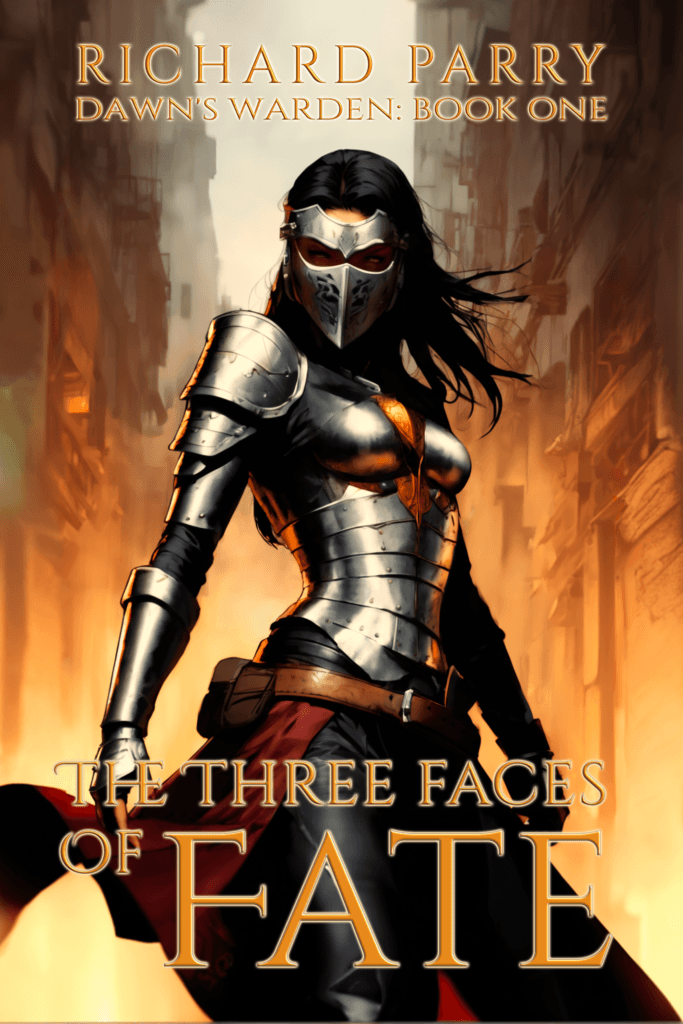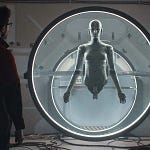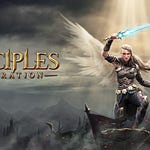Nimona is a 2023 animated action film starring Chloë Grace Moretz and Riz Ahmed. You know Moretz from Kick-Ass, Let Me In, and The Peripheral. Ahmed you’ll know from Rogue One. Now they’re both also known for Nimona, but it’s only through grit that we do.
Nimona almost didn’t happen following Disney’s shutdown of Blue Sky Studios in 2021. The film was 70% done, the team sacrificed on the altar of shareholder value but, like the titular Nimona herself, the remaining people didn’t give up. They shopped the movie around until they found a producer in Annapurna Pictures, with Netflix picking it up for distribution.
The sad thing here is that the very people who might see themselves reflected, or have their perspectives challenged in vital ways, might never know this movie exists. Unlike a Disney movie that carpet-bombs cinemas, streaming, and your grandparent’s DVD player, Nimona’s powerful messages of joy and acceptance have an artificially limited blast radius. As much as Netflix is a brand name, its films also come with the Netflix Trash™ moniker: people expect their movies to suck.
We can imagine the missed conversations sparked in households that rarely see such nuanced takes on difference simply because the film was there. Well, the good news is we now have YouTube, so I’m going to give you the best reason to renew your Netflix membership.
Acting Lessons
Moretz’s portrayal of the titular Nimona is a masterwork. She switches from an at-risk to a harmful persona in a heartbeat, using this for both comedic and emotional power. Whether she’s punching soldiers, interrogating evil people, or charming the hell out of Ballister (and us), she has a perfect nonchalant delivery that sells her character. For example, there’s an epic combat-slash-escape scene where she uses a youthful, authentic energy.
We got a glimpse of Moretz’s vocal power in The Peripheral, but it turns out that was just an appetiser. She is Nimona, a vocal shapeshifter - one minute, a vulnerable kid; the next, a terrifying monster. This isn’t just range; it’s her authenticity within that range. It’s this kaleidoscopic performance that makes Nimona feel so alive, unpredictable, and real despite being, well, a mythical creature.
A lesser actor paired with Moretz might risk being overshadowed, but Ahmed’s Ballister is the perfect anchor. Ballister is a principled-yet-troubled knight, and Ahmed embodies this internal war. Ahmed understands restraint. He knows when the script’s words are enough, or when to infuse them with the weight of Ballister’s past or his dawning empathy. You can hear the character’s journey from a man bound in chains of honour and dogma to one who gains a crucial - if initially reluctant - toehold of understanding of the being that is Nimona.
It’s his performance of Ballister grappling with and finally accepting Nimona that sticks the landing, but there’s something between Ahmed and Moretz that transcends the voice booth. The relationship between Nimona and Ballister is profound. The film doesn’t beat us with a tired romance; instead, the actors give us a ‘lived experience’ from their initial interactions through to their extraordinary friendship. Their bond is a beautiful parable for real friendship. We clash, or misunderstand, but can find forgiveness.
It’s rare and refreshing. And speaking of refreshing, let's talk about how this film looks, because that’s another area where Nimona breaks the mould.
Pink Is More Than a Colour
Fans of the channel will know my feelings on Barbie. I called for you all to give pink a chance. Well, the kings over at Blue Sky Studios were ahead of the class on this one. Nimona’s visual style is charming, avoiding the hyper-stylised Pixar look. It has a gorgeous, almost hand-drawn sensibility.
Since we’ve started on pink, let’s talk about Nimona’s design and her not-human form. For all that people see her as a monster, pink is the colour of innocence. It’s utterly non-threatening, a genius move because well before the film’s reveal of Nimona’s personality, we’re disarmed by her. We’re not scared of the monster, and this allows the film’s deeper messages to slide right on in.
Nimona’s animation favours expressive techniques that lend great strength to Nimona’s transformations. She is whatever the moment or her emotion demands. It perfectly underscores Moretz’s performance, capturing Nimona’s identity.
She is, after all, not what others expect.
Fear, Dogma, and Othering
There’s a gut-punch scene in Nimona where a child learns to fear ‘the monster’. For all that Nimona is attacked by dogmatic enforcers, what the child remembers is her transformation into a dragon as she protects Ballister. It doesn’t matter that the dragon is Barbie pink, ripped right off an in-movie cereal commercial.
The damage is done.
It’s here that Nimona earns its gold medal. It uses disarming pink and humour to show how othering is born and perpetuated. It’s not because Nimona attacks the kid. Nimona in fact saves them. But the kid has been primed by those in power, and now knows monsters are real.
Nimona, for all her amazing talents, can’t undo that. It’s a parable for those othered by our society - constantly having to justify their existence or deal with bigotry. Nimona handles this without preaching by showing you bigotry through the eyes of a child, and that message will slip under your skin and stay there forever.
In this scene, the film shows us how easily fear is ingrained in us, but crucially, also the exhaustion of being ‘othered’. There’s a lot of human hindbrain bullshit going on that makes anyone not carved of society’s pure ivory ideal of ‘normal’ feel displaced. The cure is, of course, conversation and time spent with each other. We need to just fucking talk to each other, and Nimona shows us how as it parallels LGBTQ+ struggles, classism, and racism.
This exhaustion, this constant othering - it's what makes Nimona's final act so devastating and so necessary. Because when you strip away all the noise, all the fear and prejudice and societal expectations, what are we left with? What's real?
What’s Real?
Nimona has a lot of lessons to offer. Perhaps it’s that Ballister can provide a home so Nimona can sleep deeply for the first time in her life.
Or… perhaps it’s that Nimona is the anarchic, hilarious, and moving story of a shapeshifting, thousand-year-old, perpetual teenager and a fallen knight who team up, forcing you to question everything you think you know about heroes, monsters, and the walls we build between us with our own hands.
Hell. I went into Nimona expecting a fun animated flick, and it’s that too, but for me the emotional core of Nimona is the radical power of friendship. Not just any friendship, but the kind that becomes your shield when the world tries to define you, misunderstand you, or wear you down. It suggests that true connection with those who see you is more vital than striving for acceptance from a world that might never give it.
See, friendship is more important than acceptance, or as the philosopher once said, haters gonna hate. Nimona wants you to forget about the haters and find your people. The ones who love that you’re pink with horns, because that’s how the universe made you.
Underdogs and Resurrection
Nimona’s an extraordinary tale despite being locked inside Netflix’s walled garden. It’s not special simply because it has S-tier voice acting or unique animation. It hasn’t generated a thriving fanart community simply because of the dope script.
What makes Nimona's resurrection story even more powerful is its timing. Debates about identity and belonging dominate our cultural landscape, yet here's a film that doesn't lecture or preach. It simply shows us what radical acceptance looks like. It arrived when we needed it most, a pink-horned reminder that the most transformative stories often come from the margins, whether it’s from the studios that get shut down or the characters that don't fit the mould.
There's something beautifully meta about a film that almost died finding new life to tell a story about characters who refuse to be silenced. Nimona’s been misunderstood for centuries, and in a way, the film's own journey from blood sacrifice at Disney to resurrection at Netflix reflects her persistence. Sometimes the most important stories are the ones that have to fight to exist.
Nimona proves that when you let creators tell stories about outcasts and underdogs, magic happens. And that magic isn’t down to one person or unit. To misquote Larian’s Sven Vinke about what single division made Baldur’s Gate 3 shine, he said, “Don’t be a dick - it’s all of them.” Nimona is a symphony, each creative element working in concert to amplify the others. It’s not speaking to you, but with you. From the fallen ashes of Blue Sky Studios to the rising pink tide that is Nimona, it’s a testament to the power of collaboration, a story about outcasts and underdogs, and a resurrection that lets us see one of the most meaningful films in years.
What did you think of Nimona? Let me know in the comments below. If you agree pink can be a symbol for radical acts of freedom, smash that Like button. And if you love friends who see you even on your worst hair day…
Speaking of stories about radical acceptance and found family: if you're craving more tales about characters who refuse to be silently othered, The Three Faces of Fate features characters fighting to define themselves on their own terms:












